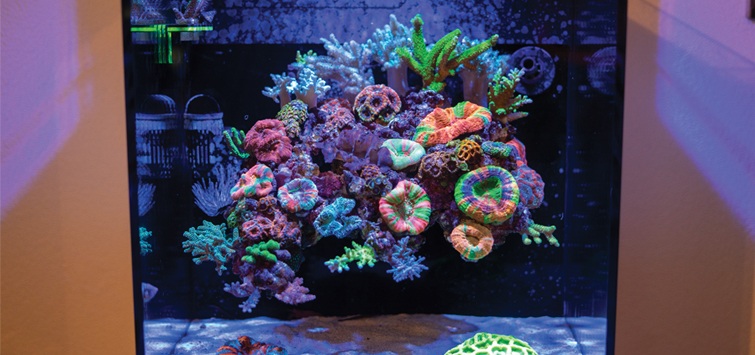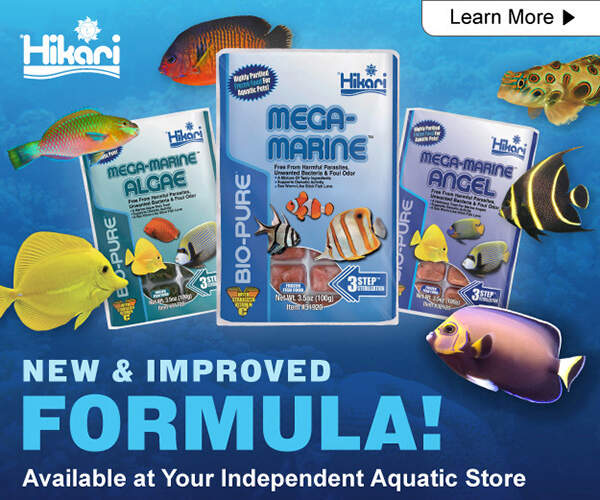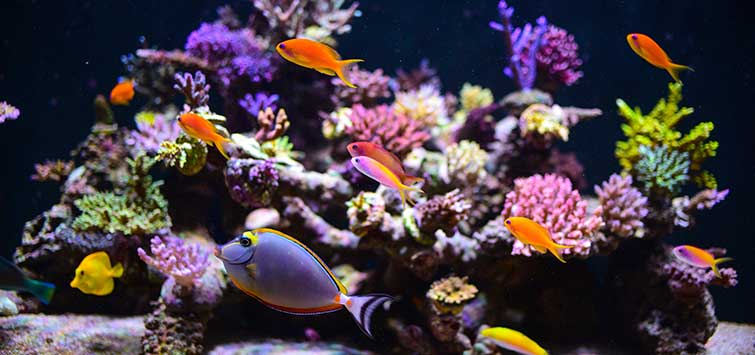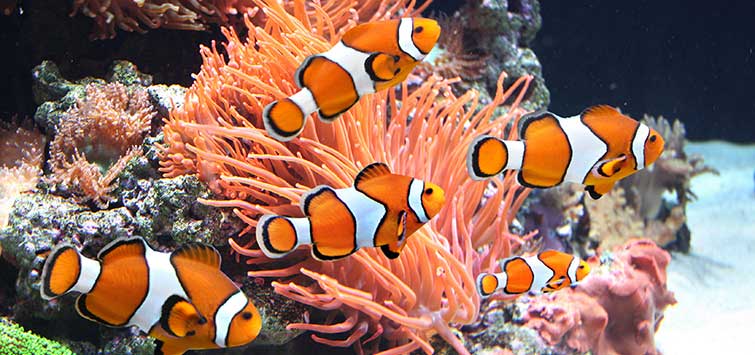How to Build a Floating Reef Aquascape
By TFH Staff (Interview with David Notter)
The first time you see it, it’s natural to do a double take. A patch of reef rock covered in bright, beautiful corals seemingly floats in mid-tank as fish and inverts go about their business on, around, and under it. David Notter, an aquarist in Switzerland who goes by Dave’s Reef on Instagram, created a “floating reef” in a 20-gallon (75-liter) nano tank that has to be seen to be believed.
Even if it were a regular “sunken” reef, his corals would look amazing. Colored up, fully expanded and healthy, they amaze and inspire his more than 25,000 followers on Instagram, getting thousands of likes on each photo he posts. Indeed, he has posted photos of his other tanks on the page, and his talent for reefscaping—and maintaining his aquaria with healthy corals and other reef life—is apparent in every shot. But it was the floating reef aquascape that piqued our interest.
We wanted to know more about this remarkable setup, and so TFH contacted Notter to talk a little about how it was conceived, how such spectacular results were achieved, and how someone interested in such a thing could build their own floating nano reef.
Where did you get the idea to build a floating reef aquascape?
The idea is not a new one, I had seen photos of floating reefs before and found it mega cool. But I didn’t know how it was done. I was first drawn to the idea purely for the optics. Only later did I recognize the many other advantages of a floating reef.
The side view gives away the illusion, the reef is on a platform that is attached the back of the tank. How did you go about creating and mounting the platform?
I used a piece of clear acrylic with a thickness of 5 mm, as the material can be bent well but is still very strong. I drilled holes into the acrylic to help facilitate water flow through the ’scape, and also to provide swim-throughs for the fish.
Silicone and acrylic do not stick together very well, so I had to make the surface where the acrylic is attached to the back glass fairly large. Then, using a whole lot of aquarium silicone, I attached the acrylic to the back glass, temporarily propping it up with another piece of acrylic to keep it in place while it dried, and I let it sit for 48 hours.
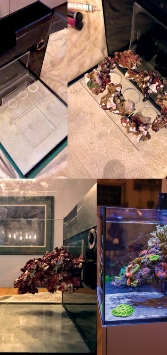
How is the rockwork arranged on the platform?
The rocks are set on the acrylic in such a way that a kind of cave-like area is created inside. The complete ’scape is not very heavy, because it has many cavities. All of the fish and inverts living in the tank can swim in and out of the rocks, breaking up sight lines and giving them somewhere to retreat to, so they can feel more secure in the tank. This was very important to me personally.
Your corals look amazing. What corals have thrived in this system, and which have given you trouble?
The basic idea of the tank was to make the corals easy to keep and grow. As you can see, I have some Scolymia in there, which are sure to be eye-catchers. But because I could provide very good and stable water conditions in this tank, I tried to keep some Acropora as well. I had a lot of experience keeping more delicate SPS corals in my former Acropora tank, so it was not very difficult for me to find a way to keep some in this tank.
The difficulty is not so much in keeping the individual corals healthy, but rather the limited space of the nano tank. I can’t keep too many species in there because they will fight each other. The corals I have in there can touch each other without doing any harm, which is key. A coral like Euphyllia or an anemone would not work very well with the others.
What fish and motile inverts do you keep in there?
I always plan ahead and get a lot of information about any potential additions before I buy them, in order to avoid problems later. Here is the tank’s current fish and invert stock list:
Fish
1 black-bar chromis
(Chromis retrofasciata)
2 blue-stripe pipefish
(Doryrhamphus excisus)
Inverts
2 yellow-banded boxer shrimp (Stenopus cyanoscelis)
2 scarlet cleaner shrimp (Lysmata amboinensis)
1 peppermint shrimp (L. wurdemanni)
1 strawberry conch (Conomurex luhuanus)
2 sand-sifting sea stars (Archaster angulatus)
6 nassa snails
20–30 turbo snails
What kind of lighting do you use?
A 60-watt LED fixture with 16 LEDs and a moonlight mounted over the tank. I don’t know much about the technical aspects of lighting, so I use a simple setting for the LED unit that is suitable for all kinds of corals.
What is the main thing you credit for making this tank so vibrant-looking?
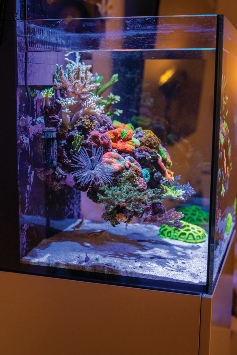
These are several factors. The most important reason is healthy corals. Healthy corals have great colors and a very nice appearance. If you want to keep SPS corals in a nano tank successfully over the long term, I find it best to dose carbonate and calcium solutions several times a day, and they are mixed with trace elements to keep the values as stable as possible. I also dose-feed the corals rather than feeding them directly.
Then there is the placement of the corals. You need a good eye for what colors, shapes, and species you place and how. Having a large amount of corals in a small tank like this also makes a big difference.
How do you keep the bottom clean under the structure?
I have some “clean-up crew” animals in there, and they help to keep the substrate clean. I must honestly admit that before it was a floating reef, I had to struggle with dinoflagellates in the tank, it was a recurring problem. It is really difficult to fight those things. I just try to keep the water parameters as stable as possible.
Occasionally there is an outbreak of algae or bacteria due to one value or another not being optimal. Areas with poor water flow are always very susceptible to such bacterial outbreaks, but this is not a problem with the floating reef.
Of course I still get algae on my rocks, so I have a lot of snails to counteract that, and I also blow off the rocks almost weekly to prevent detritus accumulations.
How often do you need to trim the corals?
Most corals are LPS which are rather slow growing, so I don’t have to cut those. The LPS corals on the edge of the rocks grow continuously towards the glass, though. I trim them every one or two months and make small frags from the cuttings.
Have the corals ever caused problems for the structure as they grow? Do they ever become too heavy?
The structure is strong enough to hold all corals even if they are still growing. And again, the rocks are arranged so the structure is essentially hollow. So I have not had any negative experiences so far in that respect.
Is a floating reef aquascape something you would try in a larger tank, or is it better for a nano reef?
I think it fits perfectly into a small tank. I know people who have tried making a floating reef in a larger setup and failed. The platform would have to be built up to be so strong and sturdy that it becomes difficult to hide, destroying the illusion. Also, with bigger tanks you have a lot of other possibilities for rockwork arrangements that look really cool. I would only recommend a floating reef setup for nano tanks.
You can see David Notter’s floating nano reef tank, as well as his other impressive reef setups, at www.instagram.com/coral_fish_zoa.
See the full article on TFH Digital http://www.tfhdigital.com/tfh/sep_oct_2020/MobilePagedReplica.action?pm=2&folio=24#pg27

.png?h=595&iar=0&w=2781&hash=5FD5E69473BCC22199FBFA2FB71B6033)
